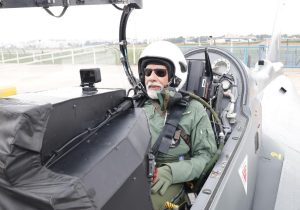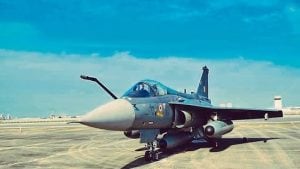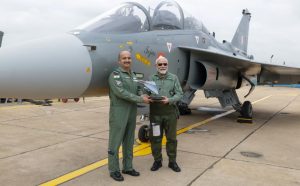Prime Minister Narendra Modi made a 30 minute flight on the Light Combat Aircraft (LCA) ‘Tejas’ on November 25, and became the first and the only Indian PM to fly an indigenous designed and produced fighter aircraft. Dressed like a combat pilot and wearing a G-suit, he flew the sortie with Group Captain Debanjan Mandal. Having operated from Indian Air Force’s (IAF), flight test centre, the Aircraft and Systems Testing Establishment (ASTE), Bengaluru, he was received and felicitated by the Air Chief, ACM VR Chaudhuri. It was all more significant, because he was flying a single-engine aircraft, when traditionally the VVIPs make flights in twin-engine aircraft like the Su-30MKI. As head of the family (government) the PM has led from the front. PM Modi tweeted that his successfully completed sortie on the Tejas was an incredibly enriching experience, and significantly bolstering his confidence in the country’s indigenous capabilities, and left him with a renewed sense of pride and optimism about India’s national potential. He further said that it was a flight to remember. Tejas is India’s pride, a manifestation of the strength and skills of 140 crore Indians.
The flight underscored the PM’s and the nation’s commitment to indigenisation. He congratulated the IAF, Defence Research and Development Organisation (DRDO), Hindustan Aeronautics Ltd (HAL), and all Indians for the great aircraft developed through a whole of nation approach. The PM also visited the world class production facilities where the ‘Tejas’ is produced, and it was of great encouragement to the engineers and technicians. [caption id=“attachment_13432652” align=“alignnone” width=“579”] Image source: X/@narendramodi[/caption] LCA: Great Design and Operational Asset The HAL Tejas is a single engine, delta wing, light multirole fighter designed by the DRDO’s Aeronautical Development Agency (ADA) and HAL. It is the smallest and lightest in its class of contemporary supersonic combat aircraft in the world. It has an indigenous fly-by-wire system, and makes extensive use of home-developed composite materials. The 4.5 generation aircraft made its first flight in 2001. The first Tejas squadron “Flying Daggers” became operational in 2016. The IAF has ordered 32 LCA Mark 1s, 73 Mark 1As and 18 Mark 1 two-seater aircraft. It has been decided to order 97 additional Mk1As. IAF has projected a requirement of nearly 200 LCA Mk2. The LCA Mk1A made its first-flight in May 2022. It can fly at Mach 1.6. It has 9 external hard-points with a capacity of 5300 kg, and provisions to carry combinations of state-of-the-art rockets; short-range and beyond-visual range (BVR) missiles; and various gravity bombs and precision guided munitions (PGM) from stand-off ranges. The initial batches have the Elta EL/M-2052 AESA fire control radar which will soon be replaced by the indigenous LRDE Uttam AESA radar. There are nearly 40 improvements over the Mk1 variant. It will have a potent electronic warfare suite. It will have an expanded weapon suite consisting of Astra BVR air-to-air missile (AAM) and Advanced Short Range AAM (ASRAAM). Many of these weapons will be of indigenous origin. The aircraft will start inducting in 2024. The Tejas Mk2 or the Medium Weight Fighter will be a larger aircraft, with more payload, and will be powered by the more powerful General Electric GE F414 INS6 engine. These American engines will be produced in India. The engines will also initially power India’s indigenous fifth-generation fighters Advanced Medium Combat Aircraft (AMCA). The first flight is expected in 2024, and the aircraft ready for series production by 2026. The Mk2 will feature a modern glass-cockpit, have an advanced AESA radar, and an integrated infrared search and track (IRST). It will have an on-board oxygen generation system and a built-in electronic warfare suite among other improvements to avionics. More internal fuel will increase the combat range. The aircraft will eventually replace the Mirage-2000, Jaguar and MiG-29s. A naval variant is also being developed. In January 2020, The Naval LCA made a successful arrested landing on INS Vikramaditya and subsequently, 18 take-offs and landings were conducted in five days. In a major milestone, the LCA naval variant made a maiden landing onboard the country’s first Indigenous Aircraft Carrier (IAC) INS Vikrant in February 2023. This was also the maiden landing of any fixed wing aircraft on the carrier as part of its operationalisation. Indian Navy’s twin-engine MiG-29K landed and take-off subsequently. As of 2022, indigenous content in the Tejas Mark 1 is 59.7% by value and 75.5% by number of line replaceable units. The indigenous content of the Tejas Mk 1A is expected to be 50% and rise to 60% by the end of the program. LCA Combat Employment LCA is a multi-role aircraft that is designed to undertake air defence, strike and maritime roles. It will be significantly used for offensive air support and provide close combat support for ground operations. Five IAF Tejas participated in its first outside India exercise Desert Flag VIII in UAE in February-March 2023. The fact that IAF deployed the aircraft in multinational exercises abroad reflects its confidence in the single-engine fighter. The LCA has been taking part in all military exercises within the country for a few years. The aircraft has had an excellent flight safety track record of accident-free flying till date. Sulur in southern Indian Peninsula has been the home base for LCA Mk1 till now. A few months back it was decided to permanently move an LCA Mk1s squadron to a forward base in Gujarat. Further it has been decided to place the first LCA Mk1A unit in a forward airbase in Rajasthan. This not only shows aircraft’s technical maturity, but also its operational capability. [caption id=“attachment_13432662” align=“alignnone” width=“657”]
Image source: X/@narendramodi[/caption] LCA: Great Design and Operational Asset The HAL Tejas is a single engine, delta wing, light multirole fighter designed by the DRDO’s Aeronautical Development Agency (ADA) and HAL. It is the smallest and lightest in its class of contemporary supersonic combat aircraft in the world. It has an indigenous fly-by-wire system, and makes extensive use of home-developed composite materials. The 4.5 generation aircraft made its first flight in 2001. The first Tejas squadron “Flying Daggers” became operational in 2016. The IAF has ordered 32 LCA Mark 1s, 73 Mark 1As and 18 Mark 1 two-seater aircraft. It has been decided to order 97 additional Mk1As. IAF has projected a requirement of nearly 200 LCA Mk2. The LCA Mk1A made its first-flight in May 2022. It can fly at Mach 1.6. It has 9 external hard-points with a capacity of 5300 kg, and provisions to carry combinations of state-of-the-art rockets; short-range and beyond-visual range (BVR) missiles; and various gravity bombs and precision guided munitions (PGM) from stand-off ranges. The initial batches have the Elta EL/M-2052 AESA fire control radar which will soon be replaced by the indigenous LRDE Uttam AESA radar. There are nearly 40 improvements over the Mk1 variant. It will have a potent electronic warfare suite. It will have an expanded weapon suite consisting of Astra BVR air-to-air missile (AAM) and Advanced Short Range AAM (ASRAAM). Many of these weapons will be of indigenous origin. The aircraft will start inducting in 2024. The Tejas Mk2 or the Medium Weight Fighter will be a larger aircraft, with more payload, and will be powered by the more powerful General Electric GE F414 INS6 engine. These American engines will be produced in India. The engines will also initially power India’s indigenous fifth-generation fighters Advanced Medium Combat Aircraft (AMCA). The first flight is expected in 2024, and the aircraft ready for series production by 2026. The Mk2 will feature a modern glass-cockpit, have an advanced AESA radar, and an integrated infrared search and track (IRST). It will have an on-board oxygen generation system and a built-in electronic warfare suite among other improvements to avionics. More internal fuel will increase the combat range. The aircraft will eventually replace the Mirage-2000, Jaguar and MiG-29s. A naval variant is also being developed. In January 2020, The Naval LCA made a successful arrested landing on INS Vikramaditya and subsequently, 18 take-offs and landings were conducted in five days. In a major milestone, the LCA naval variant made a maiden landing onboard the country’s first Indigenous Aircraft Carrier (IAC) INS Vikrant in February 2023. This was also the maiden landing of any fixed wing aircraft on the carrier as part of its operationalisation. Indian Navy’s twin-engine MiG-29K landed and take-off subsequently. As of 2022, indigenous content in the Tejas Mark 1 is 59.7% by value and 75.5% by number of line replaceable units. The indigenous content of the Tejas Mk 1A is expected to be 50% and rise to 60% by the end of the program. LCA Combat Employment LCA is a multi-role aircraft that is designed to undertake air defence, strike and maritime roles. It will be significantly used for offensive air support and provide close combat support for ground operations. Five IAF Tejas participated in its first outside India exercise Desert Flag VIII in UAE in February-March 2023. The fact that IAF deployed the aircraft in multinational exercises abroad reflects its confidence in the single-engine fighter. The LCA has been taking part in all military exercises within the country for a few years. The aircraft has had an excellent flight safety track record of accident-free flying till date. Sulur in southern Indian Peninsula has been the home base for LCA Mk1 till now. A few months back it was decided to permanently move an LCA Mk1s squadron to a forward base in Gujarat. Further it has been decided to place the first LCA Mk1A unit in a forward airbase in Rajasthan. This not only shows aircraft’s technical maturity, but also its operational capability. [caption id=“attachment_13432662” align=“alignnone” width=“657”]
LCA in Exercise Desert Flag VIII in UAE. Image: IAF[/caption] Enhanced Aircraft Production HAL has a capacity to build 16 LCA Mk-1As every year in Bengaluru and a new production line has been activated in Nashik. This will help ramp up production to a total of 24 jets. This will enable HAL to deliver the 83 fighters by 2027-28, a year ahead of the contracted delivery schedule. The IAF needs faster aircraft inductions to cater for retiring MiG 21 squadrons. LCA Export Potential LCA capabilities have been showcased through static and flying displays at India’s Aero India airshows for many years. It performed some daring manoeuvres to display its capability as a formidable fighter aircraft. HAL has also been developing a Lead in Fighter Trainer (LIFT) variant of the LCA two-seater. The aircraft had also participated in many international events, such as LIMA-2019 at Malaysia, Dubai Air Show-2021, Sri Lanka Air Force anniversary celebrations in 2021, and Singapore Air Show 2022. HAL has been in talks with many countries for possible export of the LCA. HAL was willing to set up logistic facilities in Indonesia, Malaysia, Sri Lanka and Vietnam as part of exporting the Tejas. Among the prospective customers are Botswana to replace its Canadair CF-5s with the Tejas. Egypt had once expressed interest in procuring 70 LCA Tejas to replace their 100 Chinese-made Hongdu JL-8 trainers. During Aero India 2023, it was reported that Egypt is seeking around 20 Tejas. LCA was a good contender for the Argentine Air Force, but the British sanctions affected the sale as there were some British aircraft parts including the ejection seat. Even the Royal Australian Air Force (RAAF) had shown interest, but finally no progress could be made as they decided to upgrade their existing Hawk two-seaters. Even the Malaysian deal could not succeed as finally they procured the KAI FA-50 Block 20 aircraft. Even Philippines dropped the LCA as a contender. But with an increase in production, LCA could continue to make efforts to find new export customers. [caption id=“attachment_13432672” align=“alignnone” width=“603”] Image source: X/@IAF_MCC[/caption] Way Ahead The highest dividend for the “atmanirbharta” in defence is in aviation sector. Aircraft require the leading edge technologies. No country shares technology easily, and India must build its own intellectual property. Also obsolescence sets in early. IAF’s leadership firmly backs the LCA program. In a recent review, Air Chief V R Chaudhari described the fighter aircraft as the flag-bearer of IAF’s efforts towards the indigenisation of its combat fleet. Technology for many parts and sub-sections of the aircraft has been transferred by DRDO and HAL to private sector firms, and are being manufactured by MSMEs. Over the years a defence production ecosystem has been created. It is hoped that PM Modi’s confidence exuding flight will further raise the morale of India’s aircraft designers and engineers and accelerate the design and further development. It is also hoped that it will hasten the clearances and funding of further phases of LCA and AMCA development. The writer is Director General, Centre for Air Power Studies.Views expressed in the above piece are personal and solely that of the author. They do not necessarily reflect Firstpost’s views. Read all the
Latest News
,
Trending News
,
Cricket News
,
Bollywood News
, India News
and
Entertainment News
here. Follow us on
Facebook
,
Twitter
and
Instagram
.
Image source: X/@IAF_MCC[/caption] Way Ahead The highest dividend for the “atmanirbharta” in defence is in aviation sector. Aircraft require the leading edge technologies. No country shares technology easily, and India must build its own intellectual property. Also obsolescence sets in early. IAF’s leadership firmly backs the LCA program. In a recent review, Air Chief V R Chaudhari described the fighter aircraft as the flag-bearer of IAF’s efforts towards the indigenisation of its combat fleet. Technology for many parts and sub-sections of the aircraft has been transferred by DRDO and HAL to private sector firms, and are being manufactured by MSMEs. Over the years a defence production ecosystem has been created. It is hoped that PM Modi’s confidence exuding flight will further raise the morale of India’s aircraft designers and engineers and accelerate the design and further development. It is also hoped that it will hasten the clearances and funding of further phases of LCA and AMCA development. The writer is Director General, Centre for Air Power Studies.Views expressed in the above piece are personal and solely that of the author. They do not necessarily reflect Firstpost’s views. Read all the
Latest News
,
Trending News
,
Cricket News
,
Bollywood News
, India News
and
Entertainment News
here. Follow us on
Facebook
,
Twitter
and
Instagram
.
)